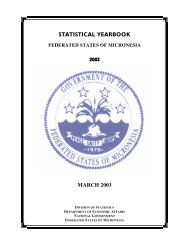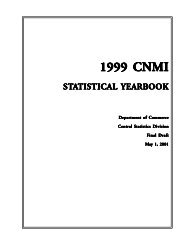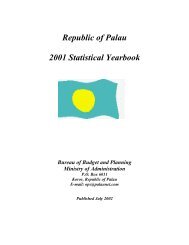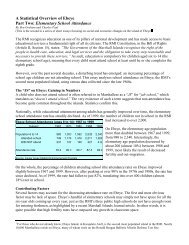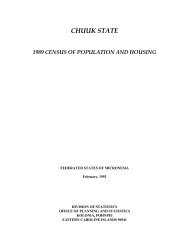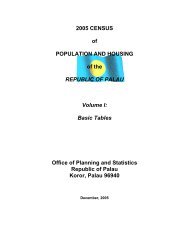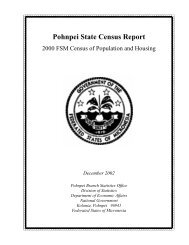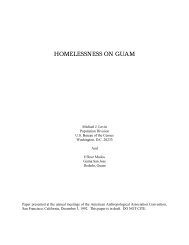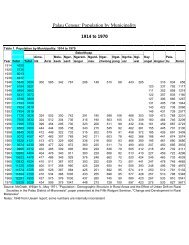Chuuk State Census Report - pacificweb.org
Chuuk State Census Report - pacificweb.org
Chuuk State Census Report - pacificweb.org
Create successful ePaper yourself
Turn your PDF publications into a flip-book with our unique Google optimized e-Paper software.
2000 FSM <strong>Census</strong> of <strong>Chuuk</strong> <strong>State</strong>Chapter 4. FertilityTable 4.6: Age-specific Fertility Rate, <strong>Chuuk</strong> <strong>State</strong>: 1973 to 2000Implied Adjusted Implied Adjusted Implied Adjusted Implied Adjusted Implied AdjustedAge groups 1973 1973 1980 1980 1989 1989 1994 1994 2000 200015 to 19 years 0.068 0.081 0.046 0.069 0.044 0.055 0.027 0.034 0.028 0.03320 to 24 years 0.291 0.346 0.200 0.301 0.208 0.260 0.126 0.162 0.139 0.16425 to 29 years 0.392 0.466 0.261 0.393 0.254 0.317 0.194 0.249 0.187 0.22030 to 34 years 0.345 0.410 0.241 0.362 0.267 0.333 0.202 0.260 0.183 0.21535 to 39 years 0.243 0.289 0.213 0.321 0.197 0.246 0.160 0.205 0.137 0.16140 to 44 years 0.104 0.123 0.124 0.187 0.102 0.128 0.119 0.153 0.070 0.08345 to 49 years 0.017 0.020 0.049 0.074 0.025 0.031 0.040 0.051 0.024 0.028TFR 7.30 8.68 5.68 8.54 5.49 6.85 4.35 5.57 3.84 4.52Adj. factor ... 1.19 ... 1.35 ... 1.08 ... 1.28 ... 1.18Source: 1973 & 1980 TTPI <strong>Census</strong>es, unpublished data; 1989 <strong>Chuuk</strong> <strong>Census</strong>, unpublished data; 1994 & 2000 FSM <strong>Census</strong>es, unpublished data.Figure 4.1 Adjusted Age-Specific Fertility Rates, <strong>Chuuk</strong>: 1973 to 2000Children per woman0.500.450.400.350.300.250.200.150.100.050.001973 1980 19891994 200015-19 20-24 25-29 30-34 35-39 40-44 45-49Source:Table 4.6Age of motherFigure 4.1 displays the changes in ASFRs over time. The reduction in the peak at ages 25 to 34 and the flattening ofthe curve at these particular ages suggest a decline in fertility. Although women aged 25 to 34 are having fewerchildren, they continue to bear children into the later reproductive years, implying small effects of contraceptives onfertility behavior. A reduction in the early reproductive ages in 2000 compared to previous census years can be seenin the figure, probably due to delay in marriage.The gross reproduction rate (GRR) and net reproduction rate (NRR) measure only female births and are indices ofgenerational replacement. The GRR is the average number of daughters born who will replace each woman in theabsence of female mortality from birth through the childbearing years. Given a TFR of 4.5, the gross reproduction ratecan be calculated by multiplying the proportion of female births by the TFR. For <strong>Chuuk</strong> in 2000, the GRR or numberof daughters a woman will have on average, was 2.1. The net reproduction rate is calculated by taking the mortality ofthe daughters into account because some daughters will die before having children. The NRR comes to 1.9. Acommon benchmark for the NRR is when the NRR equals 1, which is replacement level fertility. This implies thatexactly one woman will replace each woman after a generation. For <strong>Chuuk</strong>, the current fertility level suggests thateach woman will be replaced by about 2 women in about 31 years time (given an average length of generation is 31years).Fertility of Population SubgroupsDifferent economic and social groups tend to have varying fertility rates. It is interesting to look at the fertility rates tosee which subgroups have high fertility and which subgroups have low fertility. Considering historical parity or currentfertility can do this. In this report both parity (children ever born) and the total fertility rates are used in order tocompensate for the small numbers.Table 4.7 presents ASFRs for different educational backgrounds. A pattern seems to be evident in the relationshipbetween the fertility level of a woman and her education level. In both years, those women with higher educationalattainment had fewer children while those women with less tended to have more children. Given the 2000 fertilityrates, women with college education had on average 2.5 births over their lifetime, while women with a high school<strong>Chuuk</strong> Branch Statistics Office, Division of Statistics, FSM Department of Economic Affairs 39



